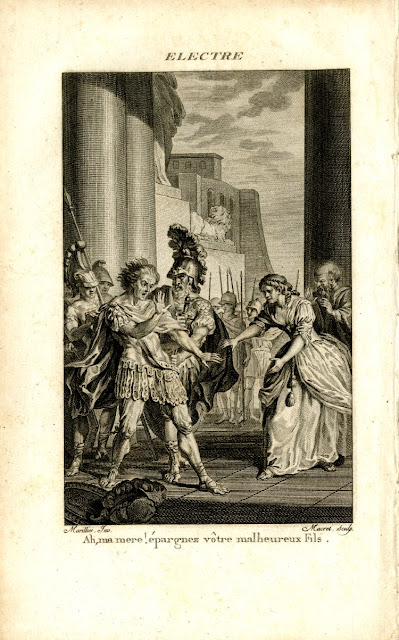 |
| Philippus Velyn Electra protecting her young brother Orestes from soldiers when their father Agamemnon is murdered by their mother Clytemnestra before 1836 etching (book illustration) British Museum |
ORESTES:
We have his remains in a small urn here –
for he's dead, as you see.
. . .
ELECTRA:
If this were all you were, Orestes,
how could your memory
fill my memory,
how is it your soul fills my soul?
I sent you out, I get you back:
tell me
how could the difference be simply
nothing?
Look!
You are nothing at all.
Just a crack where the light slipped through.
Oh my child.
I thought I could save you.
I thought I could send you beyond.
But there is no beyond.
You might as well have stayed that day
to share your father's tomb.
Instead, somewhere, I don't know where –
suddenly alone you stopped –
where death was.
You stopped.
And I would have waited
and washed you
and lifted you
up from the fire,
like a whitened coal.
Strangers are so careless!
Look how you got smaller, coming back.
OIMOI TALAINA.
All my love
gone for nothing.
Days of my love, years of my love.
Into your child's fingers I put the earth and the sky.
No mother did that for you.
No nurse.
No slave.
I. Your sister
without letting go,
day after day, year after year,
and you my own sweet child.
– from the Electra of Sophocles, translated by Anne Carson (Oxford University Press, 2001). Electra's 'speech to the urn' (quoted here only in part) was as famous in antiquity as Hamlet's 'to be or not to be' in the modern West – and it again became a famous set-piece in 18th-century dramatic adaptations of the story, but has since fallen back into an undeserved obscurity.
 |
| Anonymous Etruscan gemcutter Engraved Scarab - Electra and Orestes 5th century BC carnelian British Museum |
 |
| Meissen Royal Manufactory Orestes and Pylades ca. 1790 porcelain statuette Victoria & Albert Museum, London |
 |
| Barthélemy Roger after Jean-Michel Moreau le jeune Orestes and Electra (illustration for Voltaire's Oreste) ca. 1798-1801 etching, engraving British Museum |
 |
| Francesco Piranesi after Tommaso Piroli Sculpture group of Orestes and Electra 1783 engraving British Museum |
ELECTRA:
Surely, stranger, you're not feeling sorry for me?
ORESTES:
It shocks me, the way you look: do they abuse you?
ELECTRA:
Yes, in fact. But who are you?
ORESTES:
PHEU
What an ugly, loveless life for a girl.
ELECTRA:
Why do you stare at me? Why are you so sympathetic?
ORESTES:
I had no idea how bad my situation really is.
ELECTRA:
And what makes you realize that? Something I said?
ORESTES:
Just to see the outline of your suffering.
ELECTRA:
Yet this is only a fraction of it you see.
ORESTES:
What could be worse than this?
ELECTRA:
To live in the same house with killers.
ORESTES:
What killers? What evil are you hinting at?
ELECTRA:
My own father's killers.
And I serve them as a slave. By compulsion.
ORESTES:
Who compels you?
ELECTRA:
Mother she is called. Mother she is not.
ORESTES:
How do you mean? Does she strike you? Insult you?
ELECTRA:
Yes. And worse.
ORESTES:
But have you no one to protect you?
No one to stand in her way?
ELECTRA:
No. There was someone. Here are his ashes.
ORESTES:
Oh girl. How I pity the dark life you live.
ELECTRA:
No one else has ever pitied me, you know.
ORESTES:
No one else has ever been part of your grief.
– from the Electra of Sophocles, translated by Anne Carson (Oxford University Press, 2001)
 |
| Daniel Chodowiecki Pylades supports Orestes while Electra kneels (illustration for Electra by Friedrich Wilhelm Gotter) 1787 etching British Museum |
 |
| Charles François Adrien Macret after Clément Pierre Marillier Orestes and Clytemnestra (illustration for Electre by Claude Prosper Jolyot de Crébillon) ca. 1783 etching, engraving British Museum |
 |
| Anonymous Greek artists working in South Italy Orestes about to slay Clytemnestra ca. 340 BC Paestan red-figure neck amphora Getty Museum, Los Angeles |
 |
| Anonymous Greek artists working in South Italy Orestes slaying Clytemnestra ca. 550-525 BC terracotta relief Getty Museum, Los Angeles |
 |
| Anonymous Etruscan atists Lid - Young Man Reclining Front - Orestes and Pylades slaying Clytemnestra and Aegisthus 5th-4th century BC alabaster sarcophagus British Museum |
 |
| Anonymous Attic Greek artists Orestes, Apollo and a Fury ca. 450-440 BC red-figure column krater British Museum |
 |
| George Chinnery Orestes pursued by Furies 1811 drawing British Museum |

